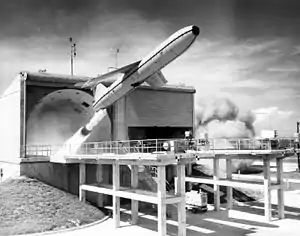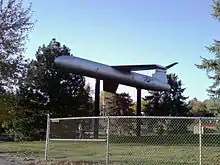MGM-13 Mace
The Martin Mace (designated TM-76A and TM-76B tactical missile until 1963, then as MGM-13A for Mobile Ground Launched Missile and CGM-13 for Coffin Ground Launched Missile) was a tactical cruise missile developed from the Martin TM-61 Matador later MGM-1 Matador. It was replaced by the MGM-31 Pershing missile by then Secretary of Defence Robert McNamara, and later in its role as a cruise missile for West Germany, by the BGM-109G Ground Launched Cruise Missile.[1]
| CGM/MGM-13 Mace | |
|---|---|
 | |
| CGM-13 test launch at Cape Canaveral | |
| Role | Cruise missile |
| Manufacturer | Glenn L. Martin Company |
| First flight | 1956 |
| Introduction | 1959 |
| Retired | Early 1970s |
| Status | Retired |
| Primary user | United States Air Force |
| Developed from | MGM-1 Matador |
History
Development began in 1954 as an improved version of the MGM-1 Matador. Like the Matador, the Mace was a tactical surface-launched missile designed to destroy ground targets. It was first designated TM-76 and later MGM-13. Compared to Matador, the Mace had a longer fuselage, shorter wings, greater range, and was heavier.
Mace MGM-13A was launched from a translauncher (transporter erector launcher) and the MGM-13B was launched from an underground bunker. Both models used a solid rocket booster for initial acceleration and an Allison J33-A-41 turbojet for cruise flight. The Goodyear Aircraft Corporation developed ATRAN (Automatic Terrain Recognition And Navigation, a radar map-matching system) in which the return from a radar scanning antenna was matched with a series of "maps" carried on a 35mm film strip on board the missile. The ATRAN navigation section corrected the flight path if the missile deviated from the flight path as carried on the film map. In August 1952, Air Materiel Command initiated the mating of the Goodyear ATRAN with the MGM-1 Matador. This mating resulted in a production contract in June 1954. The ATRAN guidance system was difficult to jam and was not range-limited by line-of-sight as in the older Matador radar command and control system, but its range was restricted by the availability of radar maps. In time, it became possible to construct radar maps from topographic maps.
The Mace was first launched in 1956 and the missile could reach Mach 0.7 to 0.85 over a 540-mile range at low level (as low as 750 feet), and 1,285 miles at high altitude. Development of Mace "B" missiles began in 1954. The Mace "A" and Mace "B" were identical in all dimensions. The Mace "B" included a jam-proof inertial guidance system (designated TM-76B) and had a flight range exceeding 1,300 miles. To enhance mobility, Martin designed the Mace's wings to fold for transport (the Matador's wings were transported separately and then bolted on for flight).
USAF deployed the Mace "A" in West Germany in 1959 at Sembach Air Base, where it briefly served alongside the MGM-1 Matador before the latter was phased out of service in 1962. A total of 6 active missile squadrons were eventually equipped with the Mace "A" at Sembach Air Base and Hahn Air Base under the (38th Tactical Missile Wing). In South Korea, the 58th Tactical Missile Group became combat-ready with 60 TM-61s in January 1959. It ceased operations in March 1962, a few months after the 498th Tactical Missile Group in December 1961 took up positions in semi-hardened sites on Okinawa.
Mace "B" missiles began were first deployed to Okinawa in 1961[2] and remained operational in Europe and the Pacific. The two squadrons of TM-76B/MGM- 13C continued on active duty in USAFE until December 1969. After being taken offline, some missiles were used as target drones because their size and performance resembled manned aircraft.
Variants
- Mace A - equipped with ATRAN (Automatic Terrain Recognition And Navigation) terrain-matching radar navigation.
- Mace B - inertial navigation system, increased range.
Locations
Mace A and B types have been deployed in Japan and former West-Germany
- Japan, Okinawa island: 873d Tactical Missile Squadron kept 32 Mace missiles on constant alert in underground bunkers at 4 Okinawa launch sites assigned to Kadena Airbase and located at Bolo Point in Yomitan, Onna Point, White Beach and at Kin just north of Camp Hansen.
- W-Germany, 38th Tac Msl Wing kept 90 missiles on alert at above and underground launcher sites assigned to Sembach Airbase (sites at Mehlingen, Enkenbach and Grünstadt); to Hahn Airbase (sites at Wüscheim, Kirchberg and Hundheim) and to Bitburg Airbase (sites at Steinborn, Idenheim and Rittersdorf)
Survivors
.jpg.webp)

Below is a list of locations which have a Mace missile in their collection or on display:
- Air Force Space & Missile Museum, Cape Canaveral Air Force Station, Florida. TM-76B / CGM-13B, AF Ser. No. 60-0715, but restored and marked as AF Ser. No. 59-4871. Originally assigned to the U.S. Air Force Tactical Missile School, 4504th Missile Training Wing, Orlando Air Force Base, Florida.
- Air Force Armament Museum, Eglin Air Force Base, Florida. CGM-13, AF Ser. No. 59-4860
- Museum of Aviation, Robins Air Force Base, Georgia. MGM-13A, AF Ser. No. 58-1465[3]
- National Museum of the United States Air Force, Wright-Patterson Air Force Base, Dayton, Ohio. This Mace "B" was based on Okinawa prior to its delivery to the museum in 1971.[4]
- Indiana Military Museum, Vincennes, Indiana. CGM-13B, AF Ser. No. 59-4871. This Mace B was assigned to the 4504th Missile Training Wing, Orlando AFB, Florida.[5]
- Belleview Park, Englewood, Colorado. Elevated outdoor display. AF Serial Number is unknown. Donated to the city by the Martin Company in the 1960s for use as playground equipment.[6]
- White Sands Missile Range Museum, New Mexico[7]
- Flagler Memorial Park, Flagler, Colorado, Mace A elevated and fenced display. AF Ser. No. 58-1463.
- McDermott Post 452, American Legion, Mildred, Pennsylvania[8]
- Ida County Veterans Memorial, Ida Grove, IA[9]
Specifications
General characteristics
- Length: 44 ft 6 in;13.6 m
- Diameter: 4 ft 6 in;1.4 m
Engine
- First stage: 1× Thiokol solid rocket booster;100,000 lbf,445 kN
- Thrust:
- Second stage: 1× Allison J33-A-41 turbojet; 5,200 lbf (23 kN)
- Thrust:
Technical information
- Launch platform:
- MGM-13A: transporter erector launcher
- CGM-13B: underground bunker
Performance
- Cruise speed: 650 mph (570 kn, 1,000 km/h)
- Operating altitude: 750 to 40,000 ft (230 to 12,000 m)
- Range: 1,400 mi (1,200 nmi, 2,300 km)
Warhead
- Warhead: W28 thermonuclear warhead
See also
Related development
Related lists
References
- Mindling, George, and Bolton, Robert, 'U.S. Air Force Tactical Missiles 1949–1969 The Pioneers', 2008, Lulu Press
- Lanning, Randall L. (15 April 1992). United States Air Force Ground Launched Cruise Missiles: A Study in Technology, Concepts, and Deterrence. Air War College, United States Air Force. AD-A258 351.
- "Mace B". Air Force Space and Missile Museum.
- "MARTIN MGM-13A "MACE"", Aircraft collection, Museum of Aviation, archived from the original on 24 June 2016.
- US Air Force Museum Foundation. US Air Force Museum. p. 94.
- Indiana Military Museum.
- Englewood Belleview Park
- "Matador, Mace", WSMR History.
- McDermott American Legion Post 252
- "CGM-13B Mace Missile Historical Marker". www.hmdb.org. Retrieved 27 August 2020.
External links
| Wikimedia Commons has media related to Martin Mace. |
- Directory of U.S. Military Rockets and Missiles
- Part One - The Development of the Matador and Mace Missiles
- Part Two - History of the Matador and Mace Missiles
- Part Three - Matador and Mace Missile Guidance and Flight Controls
- The FWD MM-1 Teracruzer
- Sembach Missileers - 38th TAC Missile Wing Missileers stationed at Sembach AB, Germany, 1959-1966
- TAC Missileers - Tactical Missile Warriors of the Cold War
- Mace - Federation of American Scientists